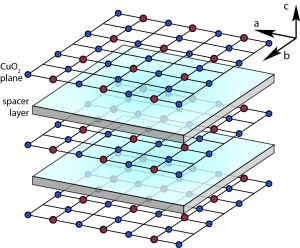Condensed matter experimental groups study a variety of materials system including:
- Topological insulators and semimetals
- Strongly correlated electron systems
- High temperature and unconventional superconductors
- Discovering materials of the future
- Exotic magnetism
- Surface and interface physics
Topological insulators and semimetals
Topological materials derive their emergent properties not by the breaking of a symmetry, but by the geometric properties of their many-electron wavefunction. Often, these materials have ‘protected’ electronic states, which are impossible to destroy with impurities. One celebrated system is the topological insulators, which are insulating on the inside but have a robust, protected, Dirac (“light-like”) electronic surface state. These materials may have applications in spintronics or next-generation electronic devices.
Groups involved: Curro, Taufour, Vishik, Yu, Zhu
Strongly correlated electron systems
One of the assumptions of 20th century condensed matter physics is that we can ignore the Coulomb repulsion between every electron and every other electron in a crystalline solid. This assumption allows us to understand the silicon in our computer chips and the copper in our home’s electrical wiring, but it fails to predict the behavior of many materials of contemporary interest. Strongly correlated electron systems are ones where the interactions between electrons are strong and cannot be ignored, and this category encompasses a number of other systems our faculty work on including high temperature superconductors and exotic magnets. Topological materials and strongly correlated electron systems together fall under the umbrella term ‘quantum materials.’
Groups involved: Curro, Taufour, Vishik, Yu, Zieve
High temperature and unconventional superconductors
How cool would it be to have a room temperature superconductor? It turns out that there are already several classes of materials that exhibit superconductivity at temperatures that were unthinkable a generation ago, and in most of these materials, there is no conclusive explanation why they become superconducting. Various groups are studying the copper-oxide (cuprate) high temperature superconductors, the iron-based high temperature superconductors, and heavy fermion unconventional superconductors in hopes of understanding why so that better superconductors can be created in the future.

Groups involved: Curro, Taufour, Vishik, Zieve
Discovering the materials of the future
From the first stone knife to the latest photo-voltaic material, the majority of the breakthrough in human civilization occurred after mastering the production and use of new materials. New materials can enable new technologies and provide solutions to pressing issues such as producing, storing, and transporting energy in a sustainable way. The search for new materials with new properties has historically been driven by curious experimental scientists that discovered most of the materials involved in our technologies so far. Today’s research involves new synthesis techniques, a better theoretical understanding of materials, and tailored characterization tools, that accelerate the path to new materials discoveries.
Exotic magnetism
When the atomic magnetic moments in a crystal line up all in parallel, a ferromagnetic order is established. Ferromagnetic materials have tremendous applications, in information storage, clean electricity production, or electric motor technologies. Exotic magnetism describes surprising and complex ways the atomic magnetic moments can arrange themselves other than the parallel configuration. Antiferromagnets, spin ice, magnetic monopoles, skyrmions, or new materials that combine interesting electric and magnetic properties are the focus of intense research with a connection to topological materials, superconductivity, and strongly correlated systems.
Groups involved: Taufour